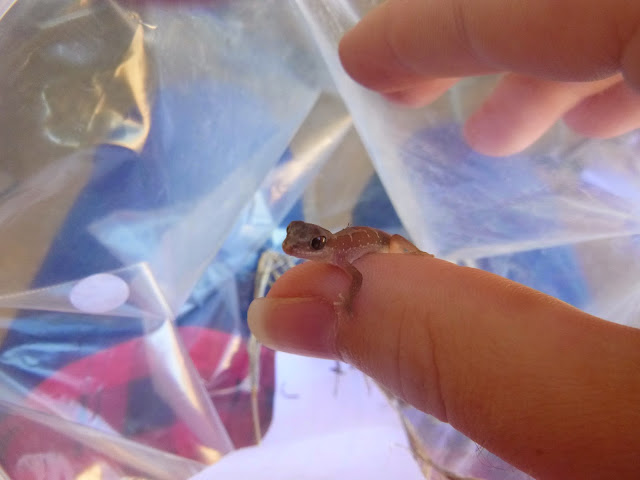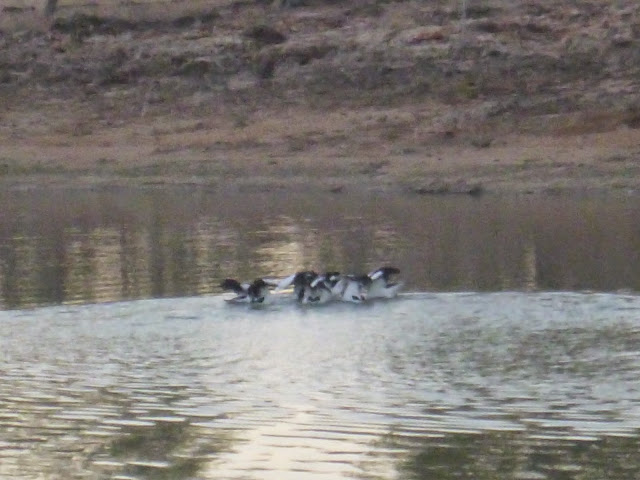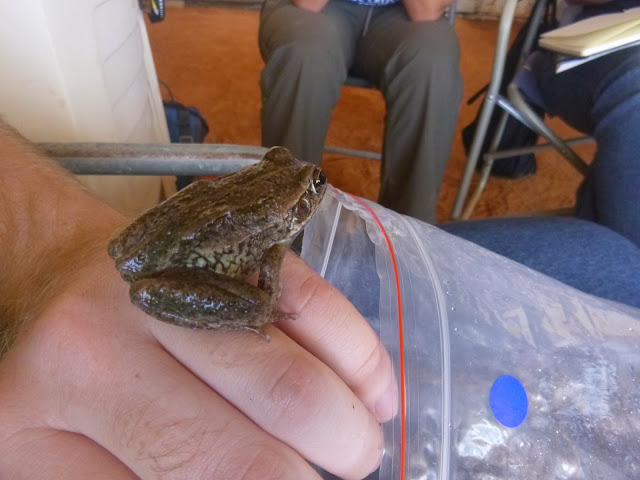Wambiana is a cattle station about an hour or so southwestish of Charters Towers. Owned by the Lyons family, it encompasses a variety of habitats, with varying grazing regimes in different areas. As such, the property is a good place to conduct studies on the effects of grazing regimes.
For this subject, we weren't looking into all that stuff, but we did get to do some trapping and handling of animals, much more low key than a full on report.
 |
| Home for a couple of days |
As Charters is out west in a
rainshadow, it gets nice and hot and dry and dusty. Our prayers for a small shower of rain were not answered, but it didn't really matter.
Upon arriving, it was straight into animal ID and keying out herps. I used this time to find cool stuff and take photos. In my defence, I also keyed out some things. Knowing what a herp looks like doesn't cut it if you don't know all the technical terms and diagnostic features.
 |
| Zig-zag gecko, Amalosia rhombifer |
 |
| Eastern Fire Tailed Skink, Morethia taeniopleura |
 |
| Box-Pattern Gecko, Lucasium steindachneri |
 |
| Dubious Dtella, Gehyra dubia |
 |
| Keelback, Tropidonophis mairii + Richard |
 |
| Spotted python, Antaresia maculosa |
After chilling with the animals for a bit, it was time to split up into our teams and head on out to the trapping site, of which there were a few. My group headed out to the bendee site first. Bendee is a type of scrub named after the most prominent plant species, the bendee acacia,
Acacia catenulata.
 |
| Emu! Dromaius novaehollandiae |
 |
| Bendee is usually found on hard rocky sites |
Upon arriving at the trapping array, we had to check the pit traps, and the funnel traps, and do some maintenance on the drift fences. The Elliot traps and cage traps had to be set and baited with a yummy smelling mammal bait (balls of peanut butter, oats, and vanilla essence).
After maintenance and baiting, it was time to go down to the lagoon to do bird and macropod surveys. Heaps of cool birds, no photos because I am shit.
 |
| Pelicans doin' their thang |
After dinner, we headed out to do some spotlighting and check the traps. Red team headed back out to the bendee where we found SWEET FUCK ALL.
I did find some herp poop though. No accompanying herp.
Following our wildly unsuccessful night at the bendee, we headed down to the bridge where there was a small pool of water where we were guaranteed to get some frogs.
 |
| Bumpy Rocket Frog, Litoria inermis |
 |
| Laughing Tree Frog, Litoria rothii |
 |
| My Desert Tree Frog, Litoria rubella |
Goodnight was said to the froggies, and we all got some much deserved sleep before getting up before sunrise to release the nocturnal animals from the traps.
This time we were out at the box site, in open woodland dominated by the Reid River Box,
Eucalyptus brownii. And we actually got stuff in the traps!
 |
| Eucalyptus brownii woodland |
 |
| Common brushtail possum, Trichosurus vulpecula |
Now that we had animals in the traps, we had to get them out without hurting them, or us. Possums are nasty screamy bitey things.
 |
| Please get in the bag |
|
 |
| A boy! |
 |
| The bitey end |
When checking the pit traps, you have to be very careful. There are some really teeny tiny species out at Wambiana, so you reeeally have to look hard or they can die in the trap. There are also some really not nice critters lurking in them.
 |
| Mottled scorpion |
We stayed out at the box to do some active search once it got warm enough for all the herps to come out. I didn't get any photos, but we did get plenty of
Carlia munda, Gehyra dubia, Heteronotia binoei, and
Morethia taeniopleura. The
Cryptoblepharus skinks were out and about, but no matter how many people we had working a tree to just get one, they always eluded capture.
Back for morning tea and ID of the frogs from the previous night, and goodies from the active search.
 |
| Litoria rothii |
 |
| Litoria alboguttata |
 |
| Bynoe Gecko, Heteronotia binoei |
 |
| Gehyra dubia |
 |
| Eastern Striped Skink, Ctenotus robustus |
 |
| Carlia schmeltzii |
 |
| Spots again |
 |
| Mottled scorpion |
 |
| Funnel web spider (more likely some sort of trapdoor) |
 |
| Nobbi dragon, Amphibolurus nobbi |
Time for a break by going out to the tip and doing some tin flipping for snakes. Of which there were none. Just more skinks and bynoes.
 |
| There was this wicked centipede though |
Then it was back out to the trapping sites to close the cages and Elliots and check the pits and funnels. This time Red Team was out at the pandanus site. As you can guess, it is an area dominated by
Pandanus cooki, and desert bloodwoods,
Corymbia terminalis. Just across the road from the lagoon, this site is usually a bit damp and boggy, but with the lack of rain all there was, was dry sand.
 |
| The Longhorns were out and about |
 |
| Pandanus are so cool |
|
 |
| General lay of the land |
 |
| More scorpions -.- |
That didn't take long, so we met up with everyone else at the lagoon to do some more birdwatching and macropod surveys. The first snake of the trip was also brought along, a baby Lesser Black Whipsnake,
Demansia vestigiata.
A pair of Eastern Grays were drinking on the opposite side of the lagoon, so someone decided to sneak up on them from the water. Had to take these through my binoculars to get a good photo.
We returned to the pandanus site later that night to do some spotlighting. The bloodwoods were flowering, so we were guaranteed to see some sugar gliders, and we did not leave disappointed. I think we ended up finding about 5 of them. Of course, because they are so tiny and flighty, I couldn't get any good photos. We also found plenty more
dubia and hets.
 |
| Tawny Frogmouth, Podargus strigoides |
Swung by the airstrip on the way back to camp and saw some spectacled hare wallabies (
Lagorchestes conspicillatus) and a rufous bettong (
Aepyprymnus rufescens).
Up early again the next morning to check and pack up traps and do some birdwatching at the riparian site.
This is what our trapping array looked like. The lined circles represent the orientation of the drift fences and pit falls. 10 Elliott traps at each drift fence (5 on either side), and a cage trap in each corner.
The log in/out system. Everyone is assigned a numbered and coloured key tag, which MUST be on the board when you are at camp, and MUST be taken with you into the field and brought back. If you go for a walk, take your tag and leave a note.
After checking the traps and walking them out, it was time to pack up the riparian site.
The buckets are left in the ground, with the pegs and rolled up drift fences inside them. Large concrete slabs are dragged over the top so that the cattle don't snap their legs.
Then it was time for the bird survey down in the dry creek bed. We saw some cool stuff, like weebills, the smallest bird species in Australia.
After bird surveys, we had to return to camp for some quick keying out of the previous night's captures, and pack up to leave. The group that went out to the ironbark site found a species I have always always ALWAYS wanted to see, a northern velvet gecko (
Oedura castelnaui). Two of them actually! Both babies.
 |
| Another Box-Patterned Gecko (Lucasium steindachneri). I love these little guys. So feisty! |
 |
| Carlia munda |
 |
| One last Nobbi Dragon (Amphibolurus nobbi) |


























































No comments:
Post a Comment